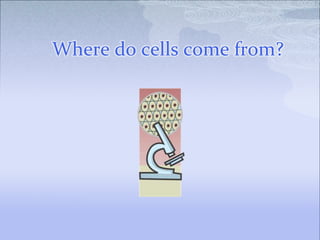
Where Cells Come From - The Cell Theory
- 1. Where do cells come from?
- 2. Cell Theory All living things are made of cells. Cells are the basic unit of life. Cells come from other cells. Schwann – animal cells 1839 Schleiden – plant cells 1839 Virchow – cell come from pre-existing cells 1855
- 3. Where did these animals come from?
- 4. What about these plants?
- 5. Characteristics of Living Things Go to your journal page and review list.
- 7. What would happen if a species could no longer reproduce?
- 8. What would happen if a species could no longer reproduce? The species would become EXTINCT.
- 9. Think about this: Where do cells come from? All organisms begin as one cell. As you learned last week, every cell contains organelles that have specific functions to carry on all of life’s processes. If reproducing is required for a species to continue, then cells must reproduce. How do cells reproduce?
- 10. Model
- 11. In unicellular (single celled) organisms, the cell divides to make new versions of itself. In multicellular organisms, the cells divide and then specialize to become different structures such as heart, brain, lungs, etc. Every day, your skin cells die and replace themselves by reproducing new ones. They do this by division.
- 12. This process of division is called Mitosis. It occurs in multiple stages or phases. You will learn the details of this process in high school biology. However, today, we are going to observe cells that are going through different stages of the reproductive process called Mitosis.
- 13. One piece of paper. Folded into 12 squares.
- 14. Microscopes
- 17. Summary After completing this investigation, where would you say cells come from? How do cells reproduce?
- 18. Summary After completing this investigation, where would you say cells come from? Cells come from other cells. How do cells reproduce?
- 19. Summary After completing this investigation, where would you say cells come from? Cells come from other cells. How do cells reproduce? Cells divide.
Notas do Editor
- http://commons.wikimedia.org/wiki/File:Onion_root_mitosis.jpg